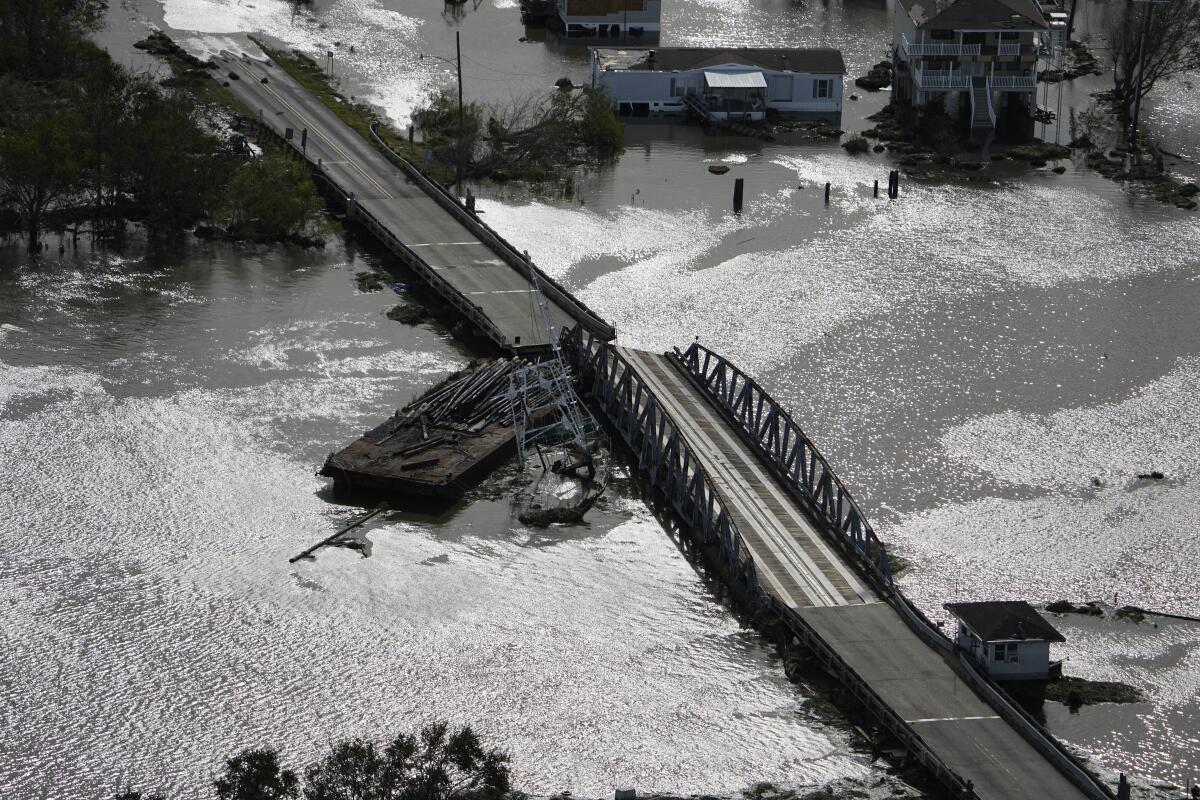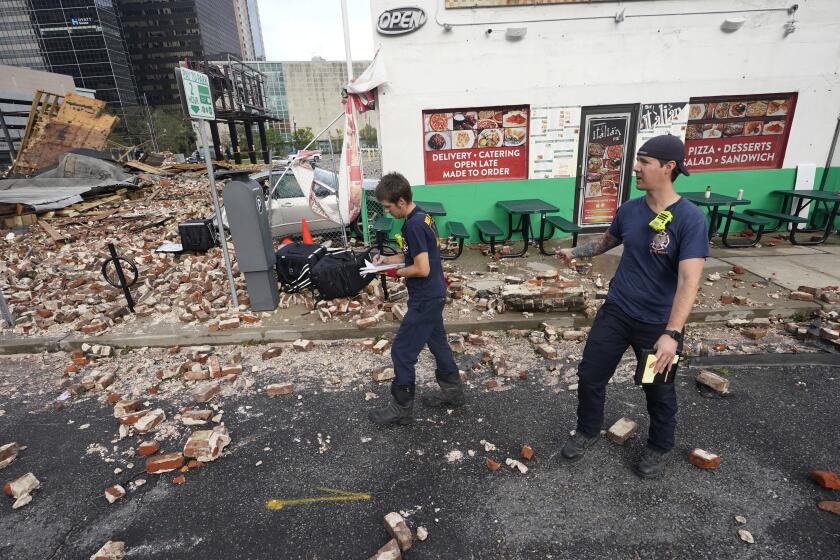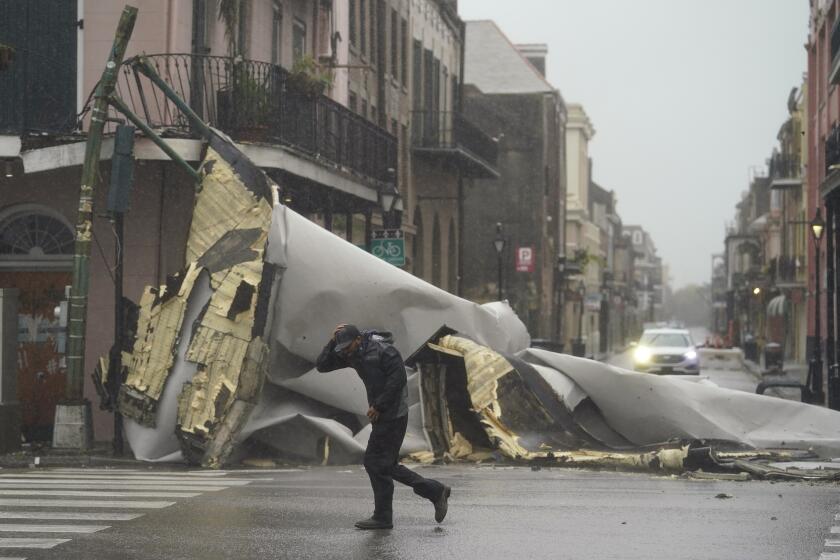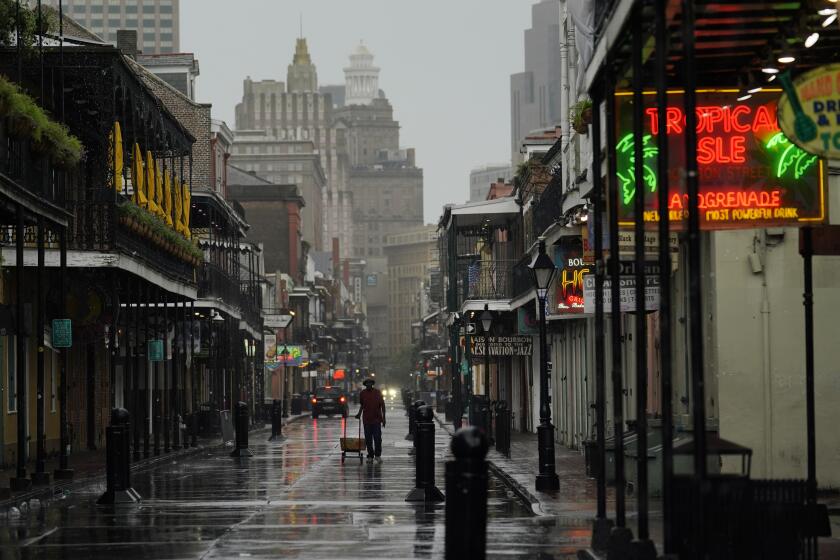Ida’s sweltering aftermath: No power, no water and little gasoline

- Share via
NEW ORLEANS — Hundreds of thousands of Louisianans sweltered in the aftermath of Hurricane Ida on Tuesday with no electricity, no tap water, precious little gasoline and no idea of when things might improve.
Long lines that wrapped around the block formed at the few gas stations that had fuel and generator power to pump it. People cleared rotting food out of refrigerators. Neighbors shared generators and used buckets of swimming pool water to bathe or to flush toilets.
“We have a lot of work ahead of us, and no one is under the illusion that this is going to be a short process,” Gov. John Bel Edwards said as the cleanup and recovery began across the soggy region in the oppressive late-summer heat.
New Orleans officials announced seven places around the city where people could get a meal and sit in air conditioning. The city was also using 70 transit buses as cooling sites and will have drive-through food, water and ice distribution locations set up on Wednesday, Mayor LaToya Cantrell said.
Cantrell also ordered a nighttime curfew Tuesday, calling it an effort to prevent crime after Hurricane Ida devastated the power grid and left the city in darkness.
The mayor also said she expects the main provider Entergy to be able to restore some electricity by Wednesday evening, but stressed that it doesn’t mean quick citywide results. Rather, she said, the energy company will be able to begin restoring its mangled distribution system of snapped poles and tangled lines.
She said residents would see progress, but also acknowledged frustration in the days ahead.
“We know it’s hot. We know we do not have any power and that continues to be a priority,” Cantrell said at a news conference.
Edwards said that state officials also were working to set up food, water and ice distribution, but that it wouldn’t start Tuesday. The governor’s office also said discussions were underway about establishing cooling stations and places where people on oxygen could plug in their machines, but it had no details on when those might be up and running.
More than 1 million homes and businesses in Louisiana and Mississippi — including all of New Orleans — were left without power when Ida slammed the electrical grid on Sunday with its 150-mph winds, toppling a major transmission tower and knocking out thousands of miles of lines and hundreds of substations.
An estimated 25,000-plus utility workers labored to restore electricity, but officials said it could take weeks.
With water treatment plants overwhelmed by floodwaters or crippled by power outages, some places are also facing shortages of drinking water. About 441,000 people in 17 parishes had no water, and an additional 319,000 were under boil-water advisories, federal officials said.
More than 1 million customers in Louisiana and Mississippi were left without power as Ida pushed through before weakening to a tropical storm.
The number of deaths climbed to at least four in Louisiana and Mississippi, including two people killed Monday night when seven vehicles plunged into a 20-foot-deep hole near Lucedale, Miss., where a highway had collapsed after torrential rains. Edwards said he expected the death toll to rise.
In Slidell, La., crews searched for a 71-year-old man who was attacked by an alligator that tore off his arm as he walked through Ida’s floodwaters. His wife pulled him to the steps of the home and paddled away to get help, but when she returned, he was gone, authorities said.
Wildlife officials warned of bears, snakes, alligators and feral hogs looking for food in the storm’s aftermath.
Edwards traveled with Deanne Criswell, administrator of the Federal Emergency Management Agency, to see the damage firsthand. She said FEMA teams arriving Tuesday would go house to house in hard-hit neighborhoods to register people for aid, particularly in areas with widespread cellphone service outages.
Hurricane Ida, hurricane, severe weather, New Orleans, Louisiana
In New Orleans, drivers lined up for roughly a quarter of a mile, waiting to get into a Costco that was one of the few spots in the city with gasoline. At other gas stations, motorists occasionally pulled up to the pumps, saw the handles covered in plastic bags and drove off.
Renell Debose spent a week suffering in the New Orleans Superdome after 2005’s Hurricane Katrina, which killed more than 1,800 people and left the city nearly uninhabitable. She said she is willing to give it a few days without electricity, but no more than that.
“I love my city. I’m built for this. But I can’t make it without any air conditioning,” she said.
Shelly Huff, who, like Debose, was waiting for gas at Costco, said: “It’s been rough. Not having power is probably the worst thing. But I have great neighbors, one who evacuated left us a generator. We’ve been sharing food and supplies, so it hasn’t been too bad.”
“I could probably last a week without electricity, but any longer and I’m going to have to get out of town,” she said.
Michael Pinkrah used his dwindling fuel to find food. He cradled his 3-week-old son in the back seat of an SUV, and his 2-year-old daughter played in the front seat as his wife stood in a long line in the sweltering heat to get into one of the few grocery stores open in the city.
A strengthening Hurricane Ida, bearing high winds and the likelihood of flooding rain as it heads for the Louisiana coast, could damage the energy-heavy Gulf Coast economy and potentially have economic consequences well beyond the region.
Pinkrah said he and his wife thought about evacuating but couldn’t find a hotel room. They found out about the open store through social media. But even that link was tenuous.
“We can’t charge our electronic devices to keep in contact with people,” he said. “And without that, all of the communication just fails.”
In hard-hit Houma, the dismal reality of life without air conditioning, refrigeration or other more basic needs began to sink in.
“There’s no electricity. Our desperate need right now is tarps, gasoline for generators, food, water,” pastor Chad Ducote said. He said a church group from Mississippi arrived with some food and supplies, which were gone in 10 minutes. Neighbors came to Ducote’s pool to scoop up buckets of water.
“The people down here are just doing what they can,” he said. “They don’t have anything.”
Start your day right
Sign up for Essential California for the L.A. Times biggest news, features and recommendations in your inbox six days a week.
You may occasionally receive promotional content from the Los Angeles Times.
Adding to the misery was the steamy weather. A heat advisory was issued for New Orleans and the rest of the region, with forecasters saying the combination of high temperatures and humidity could make it feel like 105 degrees Tuesday and 106 on Wednesday.
Also stuck in New Orleans were tourists who didn’t get out before the storm. The airport canceled all commercial flights for a third day, saying the lack of power and water meant no air conditioning or restrooms.
Cynthia Andrews couldn’t go back to her New Orleans home even if she wanted to. She is in a wheelchair, tethered by a power cord to the generator system running the elevators and hallway lights at Le Meridien hotel.
When the power went out Sunday, the machine that helps Andrews breathe after a lung collapse in 2018 stopped working. The hotel let her stay in the lobby, giving her a cot after she spent nearly a whole night in her wheelchair.
“It was so scary,” she said, “but as long as this thing keeps running, I’ll be OK.”
Deslatte reported from Thibodaux, La. Associated Press writers Janet McConnaughey, Rebecca Santana and Stacey Plaisance in New Orleans; Jay Reeves in Houma; Alina Hartounian in Scottsdale, Ariz.; Sudhin Thanawala in Atlanta; Jeff Martin in Marietta, Ga.; and Jeffrey Collins in Columbia, S.C., contributed to this report.
More to Read
Sign up for Essential California
The most important California stories and recommendations in your inbox every morning.
You may occasionally receive promotional content from the Los Angeles Times.
















